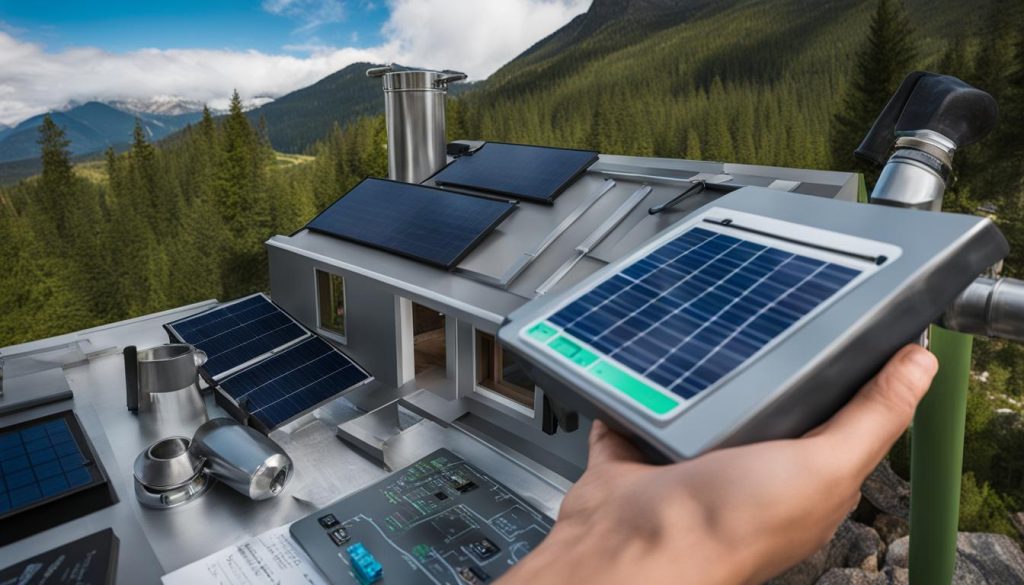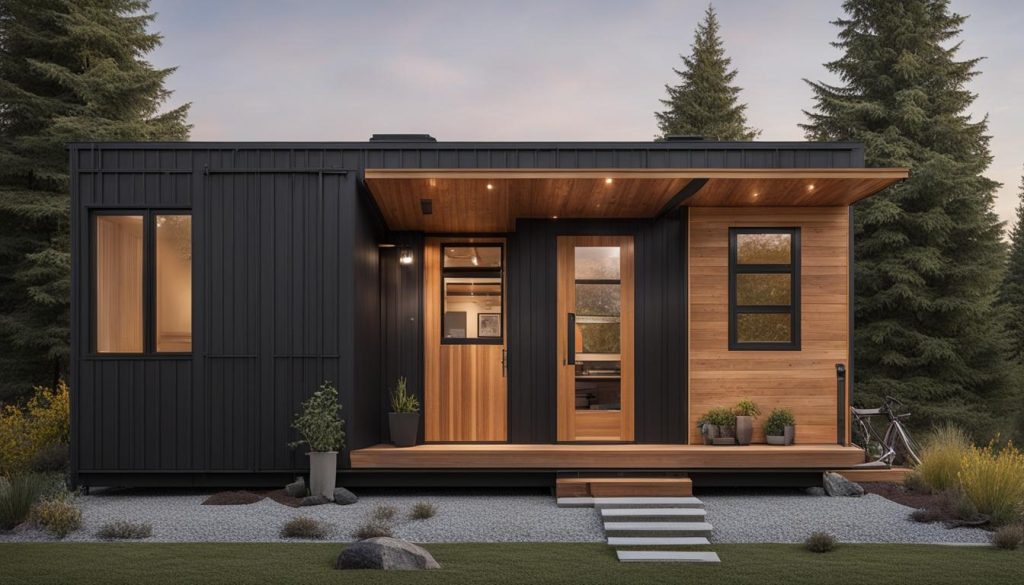Tiny House Plumbing Costs Unveiled
Did you know that plumbing expenses can account for a significant portion of a tiny house budget? When it comes to plumbing a small house, expenses can quickly add up, leaving homeowners wondering how much it really costs to plumb a tiny house.
Whether you’re building a new tiny home or renovating an existing one, it’s crucial to understand the factors that contribute to plumbing costs and explore cost-saving strategies to stay within your tiny home plumbing budget. In this article, I will delve into the world of tiny house plumbing costs, identify common plumbing expenses, discuss factors influencing these costs, and provide useful tips on reducing your plumbing expenses.
Key Takeaways:
- Understanding the factors that affect plumbing costs
- Implementing cost-saving strategies when designing and maintaining a tiny house plumbing system
- Regular maintenance and prompt repairs can save money in the long run
- Choosing affordable materials and fixtures
- Considering DIY repairs if possible
Identifying Common Plumbing Expenses
When it comes to plumbing a tiny house, it’s essential to be aware of the common expenses that may arise. Understanding these costs can help you plan your budget effectively and avoid potential financial surprises down the line. Here are some key plumbing expenses to keep in mind:
Leak Repairs and Detection
Addressing leaks promptly is crucial for both the functionality of your plumbing system and your budget. Even a minor leak can lead to significant water waste and potential property damage. Regularly inspect your tiny house for any signs of leaks and ensure they are fixed as soon as possible. This proactive approach can save you money on both water bills and repairs in the long run.
Pipe Replacements and Repairs
Over time, pipes in your tiny house may require replacement or repair. Opting for cost-effective options like PEX pipes can help minimize expenses without compromising the quality of your plumbing system. By choosing durable and reliable materials, you can ensure the longevity of your pipes and avoid unexpected leaks or bursts.
Fixture Installations and Upgrades
Choosing compact and efficient fixtures designed specifically for tiny houses is essential. These fixtures not only optimize space but also help reduce water consumption and utility costs. Investing in high-quality fixtures that are built to last can save you money in the long term by decreasing the need for frequent replacements or repairs.
Drain Cleaning and Maintenance
Maintaining clear and clog-free drains is key to preventing potential plumbing issues in your tiny house. Regularly cleaning and maintaining your drains can help avoid costly blockages and backups. Simple practices like using drain screens, being mindful of what goes down the drain, and periodically flushing drains with hot water and vinegar can go a long way in keeping your plumbing system running smoothly.
By understanding and considering these common plumbing expenses, you can better estimate the overall plumbing cost for your small house. In the next section, we will delve into the various factors that can affect your plumbing expenses, allowing you to make informed decisions when planning your tiny house water system.
Factors Affecting Plumbing Costs
When it comes to plumbing a tiny house, several factors can influence the overall cost. It’s essential to consider these factors to ensure that you stay within your budget while still maintaining a reliable and efficient plumbing system.
1. Property Size and Layout
The size and layout of your tiny house will directly impact the amount of piping needed for your plumbing system. Larger properties or those with complex layouts may require more materials and labor, increasing the overall cost.
2. Plumbing System Age and Condition
If you’re renovating or retrofitting an existing tiny house, the age and condition of the plumbing system can affect the cost. Older systems may require more repairs and replacements, adding to the overall expenses.
3. Local Plumbing Service Rates
Plumbing service rates can vary based on the location and demand in your area. It’s always a good idea to research and compare local plumbing service rates to ensure you’re getting fair pricing for your project.
4. Emergency vs. Non-Emergency Services
In some cases, you may require emergency plumbing services for unexpected issues. Keep in mind that emergency services typically come at a higher cost due to the immediate response and after-hours availability.
To get an estimated cost to plumb a tiny house, it’s advisable to consult with local plumbing professionals who can provide accurate quotes based on your specific needs and requirements. By considering these factors and making informed decisions, you can plan your tiny house plumbing project effectively and minimize any budget surprises.
5 Tips to Reduce Tiny House Plumbing Cost
When it comes to plumbing your tiny house, affordability is key. Choosing cost-effective materials and implementing smart strategies can help you save on your plumbing expenses. Here are five tips to reduce your tiny house plumbing costs:
-
Regular Maintenance and Inspections
Prevention is always more cost-effective than repair. By conducting regular maintenance and inspections, you can identify and address potential issues before they escalate into costly problems.
-
Early Leak Detection
Water leaks not only waste a precious resource but can also lead to significant property damage. Stay vigilant and promptly address any signs of leaks to save water and prevent further expenses.
-
Addressing Plumbing Issues Promptly
Ignoring plumbing issues can lead to more extensive damage and higher repair costs. Whenever you notice a problem, such as clogged drains or leaking pipes, take immediate action to prevent further damage and expenses.
-
Choosing Cost-Effective Plumbing Materials
Opt for affordable plumbing materials that still offer durability and quality. PVC pipes, for example, are a cost-effective alternative to traditional copper pipes. Research and compare prices to find the best options for your tiny house plumbing system.
-
DIY Plumbing Repairs If Possible
If you have the skills and knowledge, consider taking on minor plumbing repairs yourself. DIY repairs can help you save on professional service fees. However, be cautious and know your limits. For complex or major issues, it’s best to consult a professional plumber.
| Tips to Reduce Tiny House Plumbing Cost | Impact |
|---|---|
| Regular maintenance and inspections | Prevents costly issues and extends the lifespan of the plumbing system |
| Early leak detection | Saves water and prevents property damage |
| Addressing plumbing issues promptly | Prevents further damage and expenses |
| Choosing cost-effective plumbing materials | Saves money on materials without compromising quality |
| DIY plumbing repairs if possible | Saves on professional service fees |
Key Takeaways on Reducing Plumbing Costs
When it comes to plumbing a tiny house, understanding the factors that affect the overall cost is crucial. By implementing cost-saving strategies and following a few key tips, you can keep your plumbing expenses in check and stay within your budget.
Firstly, regular maintenance and prompt repairs are essential in preventing costly issues down the line. By addressing plumbing problems early on, you can avoid further damage and costly repairs. Additionally, choosing affordable materials and fixtures can significantly reduce your plumbing costs. Opting for cost-effective options without compromising on quality is a smart way to save money.
Furthermore, taking a proactive approach by performing regular maintenance and inspections can help identify potential issues before they become major problems. By staying on top of your plumbing system’s upkeep, you can save on repair and replacement costs in the long run.
Lastly, consider the possibility of DIY repairs if you have the necessary skills and knowledge. While it’s essential to know your limitations and seek professional help for complex tasks, tackling simple plumbing repairs on your own can save you money on labor costs.
- Investing Wisely: How Windows & Doors in Boost Property Value and Financial Health - April 24, 2025
- The Financial Impact of Personal Injuries: Why Legal Help Matters for Business Owners - April 16, 2025
- The Hidden Financial Costs of Domestic Assault: What Business Owners Need to Know - April 16, 2025













